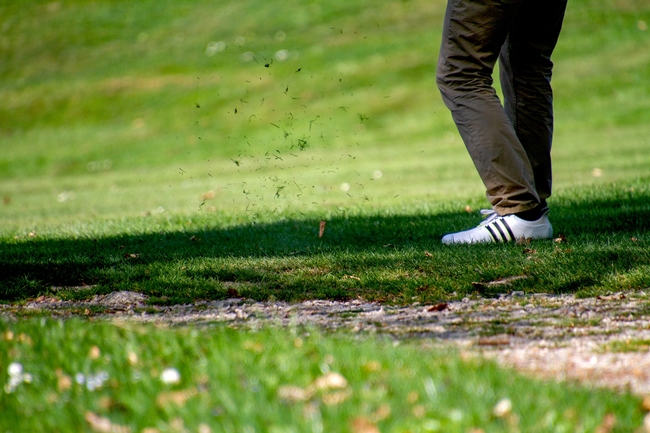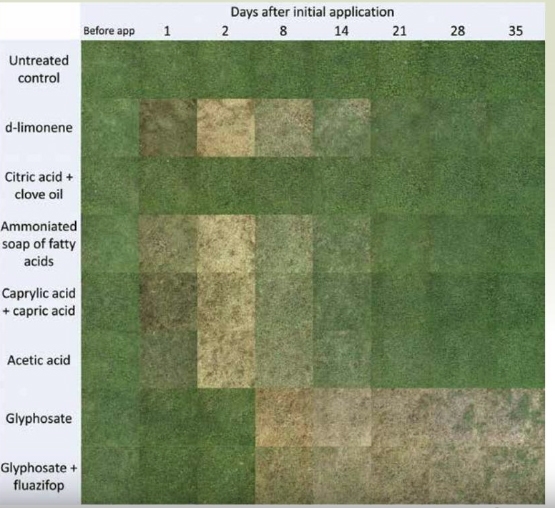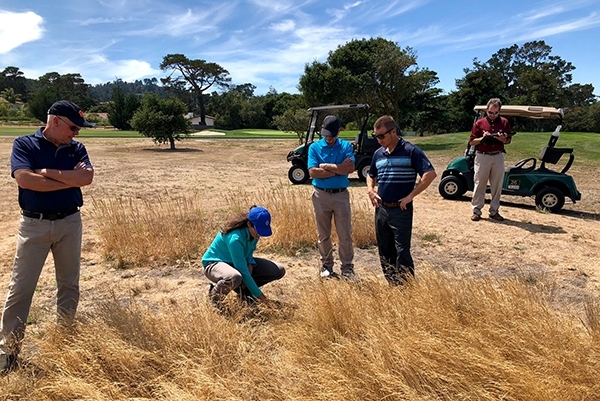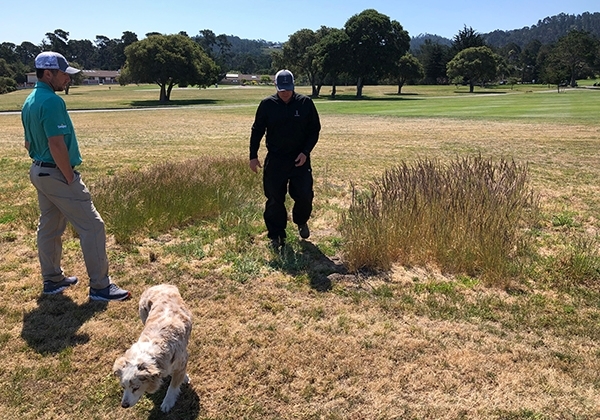
Posts Tagged: Turfgrass
Oh Dallisgrass
Knowing what weedy grass you have in your lawn or landscape is very important in being able to...
UC Cooperative Extension studies organic herbicides for weed control in landscapes
The safety of the weed killer glyphosate, the active ingredient in some well-known Roundup products, has been the subject of attention recently because of lawsuits that connected the chemical to cancer in humans.
Based on extensive scientific research, U.S. regulatory agencies have not banned glyphosate, but the publicity has increased interest in alternatives to the herbicide, which is the most widely used pesticide in the world.
“Everybody is really clamoring for information,” said area integrated pest management advisor Karey Windbiel-Rojas. “Efficacy of organic herbicides is one of the most popular talks I am giving at the moment.”
Windbiel-Rojas and former UC Cooperative Extension environmental horticulture advisor Maggie Reiter launched research projects in 2019 to help fill knowledge gaps on the effectiveness of organic herbicides in urban landscapes – such as lawns, golf courses, parks, cemeteries and school grounds. (Reiter has since taken an extension educator position at the University of Minnesota.)
Organic herbicides are pesticides made of compounds that occur in nature; and synthetic herbicides are compounds developed in laboratories. While both can be more toxic or less toxic to people and the environment, some people prefer using organic methods or chemicals.
On a small scale, a variety of organic solutions to weeds are readily available – such as hand pulling, hoeing and mulching. For larger jobs, professional landscape managers prefer applying an herbicide and look to UC Cooperative Extension scientists to know how well different options will work.
Reiter set up a study on at Ridge Creek Golf Course in Dinuba, and Windbiel-Rojas set up a study on a landscaped area with a mix of grasses and weeds in a parking lot at Sacramento State University.
In the Dinuba experiment, Reiter applied organic herbicides on 25-square-foot plots in four replications. The active ingredients of the organic herbicides included such naturally occurring chemicals as citric acid, clove oil, orange oil, acetic acid (vinegar four times stronger than that found in most home pantries), soaps, and caprylic acid, which comes from coconut and palm kernel oils.
The plots treated with citric acid and clove oil remained as green and lush as the grass in the control areas, which hadn't been treated at all. The areas sprayed with the other organic herbicides showed significant injury two days after treatment. However, 19 days post-treatment the plots treated with caprylic acid and herbicide soaps had completely recovered. The plots treated with orange oil and acetic acid recovered after 28 days.
In the Sacramento State trial, Windbiel-Rojas used some of the same organic compounds, plus others with different natural ingredients, such cinnamon oil, pelargonic acid and ammonium nonanoate, which are drawn from fruit, vegetables and other plant sources.
Many products burned down both grasses and broad-leaf weeds after a few days, however, a couple weeks later, the weeds began to regrow or recover. In addition, some of the organic treatments are more acutely toxic to people than glyphosate.
“While organic, 20% acetic acid is very toxic to the person applying the herbicide,” Windbiel-Rojas said. “It will burn one's skin, hair and eyes so the applicator must wear more personal protective equipment than with some other herbicides. This material is also problematic to use in a public space because any bystanders could be exposed to drift during application.”
The research was published in the February 2020 issue of CAPCA Adviser Magazine. The findings of the research on organic herbicides for turfgrass are preliminary and UC IPM researchers will continue to investigate options.
Windbiel-Rojas will present “Glyphosate Alternatives and Organic Herbicides in Landscapes: Efficacy and Tradeoffs” at the Pesticide Applicators Professional Association Zoom webinar Dec. 2. View the agenda here: https://www.papaseminars.com/uploads/Seminars/11643.pdf. For more information and the registration link, visit https://www.papaseminars.com/seminars.
Lawn Problems: Diseases Are Not Always To Blame
Your customers want their lawns to be beautiful and functional (Figure 1) but dead patches or other...
Golf courses go wild
When we think about golf courses, we tend to picture miles of well-watered, uniformly clipped, and perfectly manicured grass, not drought-tolerant native grass, wildlife habitat and ecological restoration. However, for Maggie Reiter, a UC Cooperative Extension turfgrass and environmental horticulture advisor based in Fresno County, this is par for the course.
“I've always worked in the turfgrass and golf course management domain,” said Reiter. “Since I began 12 years ago, the proportion of naturalized areas on golf courses has increased. Now native grass stands and wildlife habitat are projected to make up 26% of golf course facilities. From a research and extension perspective, there is little information on management of these natural areas. So, there is a need for expertise on managing golf course naturalized areas for multiple functions, including ecological restoration goals.”
Reiter works with golf course superintendents, who she says are professional stewards of the land. Superintendents seek new methods of maintenance that require less water, fertilizer and labor and promote landscapes that support biological diversity and conservation, in addition to providing a high-quality arena for golf. Golf courses have the potential to provide ecosystem services and community-wide ecological benefits, such as capturing stormwater runoff, providing wildlife habitat, sequestering carbon and relieving urban heat island effects.
One approach Reiter takes to meet these goals is to reduce the amount of maintained turf by converting the less frequently played areas of golf courses to native grasslands. Determining the ideal varieties of grasses to plant can be challenging since there are more than 250 grasses native to California. Native grass seeds are more expensive and less readily available than traditional turfgrasses, which limits the options for use in restoring native grasslands in landscapes. Reiter and her team were able to test only 13 native grasses in their field trials. In addition, the establishment period for native perennial grasses can be two to five years, in contrast to traditional turf varieties that take a few months.
“That is a surprising challenge I didn't anticipate,” Reiter explained. “Golf course superintendents have expectations for naturalized area establishment that do not align with reality because these California native grasses are so different from conventional turfgrasses. I've spent a tremendous amount of time communicating with golf course superintendents, managers, golfers, and other stakeholders to establish realistic expectations.”
Once the experimental grasses are established, Reiter, a golfer herself, has to determine the playability of each variety. Playability of a grass has to do with a player's ability to find the golf ball and advance the ball through the grass and is an important factor in designing naturalized areas. Poor playability on a course can slow down the pace of play, which detracts from the golfer's experience. Measuring stand height, plant density and aboveground biomass indicate visual obstruction, but does this determine playability?
“Measuring playability is an enigma that I think about often, and have no good answer for at this point. There is no consensus in the turfgrass research world on how to measure these complex habitats,” Reiter said. “Engaging in the golf course landscape by playing helps me feel things from the golfer's perspective.”
When Reiter is not on the golf course or working on field trials, she advises schools, parks and recreational sports fields and provides education on general turfgrass management for her local Master Gardener programs as part of her extension work. It turns out that parks and schools are facing major challenges similar to those on golf courses – they need to conserve water and absorb rising labor costs. Reiter says that golf courses may have more resources to respond to these problems, but the tradeoff is that they have higher expectations for aesthetics and performance from native grasses.
Reiter is relatively early in her career, but no doubt she will continue to work with her partners on golf courses and beyond to solve grand problems and incorporate native grasslands within traditional turf areas. It is clear that she is passionate about improving land management practices to protect California's natural resources and promote community health and wellness.
“It is important to me to increase the ecological sustainability of golf courses, and more widely, urban landscapes,” Reiter said.
This article was first published with more photos in The Confluence, the California Institute for Water Resources blog.
"Mosquito Eaters" and Mosquitoes
Warmer weather means many pests are flying and joining you indoors while you shelter-in-place or...




